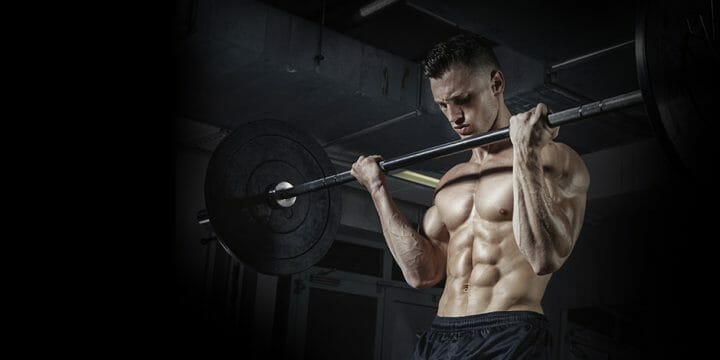Creatine supplementation has become one of our most recommended approaches to bodybuilding and weight training.
But many clients we work with have difficulty with the concept of using a creatine loading phase to get started.
So, we worked with a diet and nutrition expert to bring you details of what creatine loading is, whether it’s necessary, and how to implement it.
Let’s get right to it.
Quick Summary
- Creatine loading involves taking higher doses of creatine to quickly saturate muscles, potentially enhancing exercise performance and muscle recovery.
- While not essential, creatine loading can benefit those with naturally lower creatine stores, such as vegetarians or individuals aiming for rapid improvements in muscle mass.
- Studies suggest creatine loading can improve muscle strength and performance by up to 15% during high-intensity, short-duration exercises.
- From our team experience, a disciplined creatine loading phase, followed by consistent training, can significantly expedite muscle gains and recovery.
What Is Creatine Loading?

Creatine loading is an approach to taking larger doses of creatine to maximize your creatine stores over a few days and weeks.
The idea behind it is simple.
Without taking any creatine supplements, your muscles’ creatine storage will only be about 70% full [1].
The main idea behind a loading phase is that you saturate your muscles over a few days with up to 20 grams of creatine per day.
More on this shortly.
What this does is increase the amount of adenosine triphosphate (ATP) that your body produces, boosting your raw energy levels for better exercise performance and muscle recovery.
Drawing from my competitive days, I question whether this step is essential for everyone or just those looking for a competitive edge.
Is Creatine Loading Necessary?

No, it’s not essential to start taking creatine with a loading phase. If you take the regular daily recommended dosage, you’ll ultimately achieve higher muscle creatine stores and increased muscle strength.
However, creatine loading can be particularly beneficial for:
- Individuals who typically have lower creatine stores due to their diet lacking meat (vegans and vegetarians), which is a primary natural source of creatine [2],
- Individuals seeking quicker results in achieving lean body mass, as it accelerates the effectiveness of creatine supplements, allowing for the full benefits to manifest sooner than with standard dosing.
“[Short-term] Creatine supplementation may improve mean total work, total work normalized per repetition, and total number of repetitions during a repetitions-to-failure (RFT) test that is performed in a fatigued condition.”
- Joshua Feuerbacher, Researcher at Department of Molecular & Cellular Sports Medicine
But let’s take a closer look at the benefits.
Advantages Of Creatine Loading

Based on our own experience and the work we do with clients, we have identified the main benefits of implementing a loading phase.
1. Faster Muscle Gains
Creatine supplementation, in general, may lead to faster muscle growth when combined with strict and effective weight and exercise routines.
And that’s an important factor.
Creatine is not a magic pill to make you look like Mr. Universe.
But the reason we’ve seen faster muscle gains is down to gaining a few weeks of a headstart where the body’s creatine stores are maximized sooner with a loading approach.
2. Better Muscle Recovery

Studies conducted by the International Society of Sports Nutrition have shown that creatine may play a key role in recovering from resistance training [3].
And when that happens at an earlier stage of a training plan, there may be significant benefits to how soon people are ready for the next workout session.
Also, less soreness and stiffness in muscles may reduce how prone you are to injuries.
3. Improved Strength
Once the body has maximized creatine storage, there may also be a noticeable improvement in ATP production, which is the raw energy that muscles need when they are under maximum tension.
Research endorsed by the International Society of Sports Nutrition suggests that creatine loading can improve muscle strength and total work performed by up to 15% during intense, short-duration activities [4].
Related Articles:
Disadvantages Of Creatine Loading

Creatine supplements are generally regarded as safe, with little to no side effects.
The Mayo Clinic cautions that creatine loading can lead to stomach discomfort, so people with a sensitive stomach may have difficulty taking one large dose [5].
But that often comes down to a problem with protein absorption and is rare
According to the National Institutes of Health, creatine loading can lead to rapid weight gain, with individuals gaining an average of 0.8 to 2.9% of body weight in the first few days due to increased muscle creatine and water content [6].
Hence, to reduce these potential side effects, I recommend athletes drink more water during the loading phase to balance the water retention in their muscles and maintain their best performance and health.
Finally, the National Kidney Foundation warns that individuals with pre-existing renal conditions should avoid creatine loading due to the increased workload on the kidneys during the elimination of creatine waste products [7].
How Do You Plan A Creatine Loading Phase?

The International Society of Sports Nutrition says that doses up to 30 grams per day are classified as safe, which gives plenty of room for an effective loading protocol.
Loading Phase
Based on all the research data we found and the recommendations from official sports organizations, we generally recommend taking 20 grams of creatine per day for seven days when you first get started.
Now, the important thing is that this shouldn’t be all taken in one go. have seen the best results by splitting it into three doses.
Take one in the morning with breakfast, then one before your workout, and one after your workout.
Remember, a loading phase means you'll go through your creatine supply faster—something I learned quickly during my early competitive days.
Maintenance Phase
Once you’ve reached maximum saturation levels (usually after a week of loading), you can reduce your daily supplement dose to the generally recommended 3-5 grams per day.
Research suggests that this is enough even for high-performance athletes, as any surplus is simply flushed out of your system.
Also, once you’re in maintenance mode, there’s no need to load creatine again.
Do You Need An Off-Cycle?

With many other supplements, there is a tendency that your body gets used to the ingredients and eventually doesn’t react as effectively.
Is this the case with a daily dose of creatine?
The science isn’t clear here, but I have seen people use moderate creatine doses daily for more than six months after the initial muscle creatine loading.
And they were able to maintain the effects.
It’s a substance that your body needs for basic functions, and it will naturally maintain certain creatine levels. That’s why we wouldn’t say off-cycles are necessary.
References:
- https://pubmed.ncbi.nlm.nih.gov/21346331/
- https://www.ncbi.nlm.nih.gov/pmc/articles/PMC7246861/
- https://jissn.biomedcentral.com/articles/10.1186/s12970-017-0173-z
- https://jissn.biomedcentral.com/articles/10.1186/1550-2783-4-6
- https://www.mayoclinic.org/drugs-supplements-creatine/art-20347591
- https://www.ncbi.nlm.nih.gov/pmc/articles/PMC5469049/
- https://www.kidney.org/atoz/content/serum-blood-creatinine
About The Author
You May Also Like






